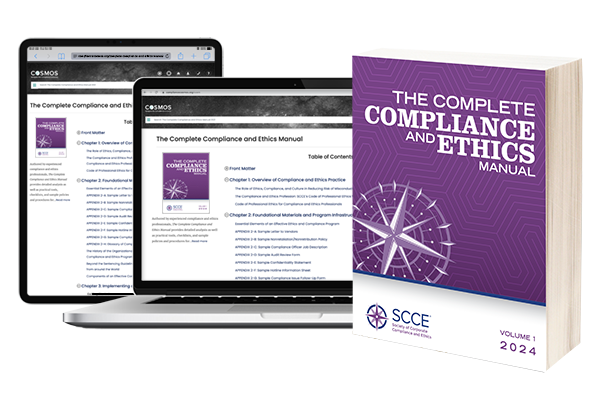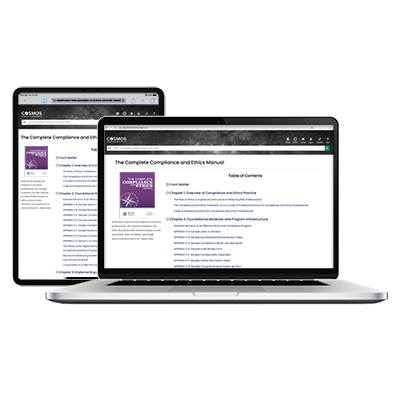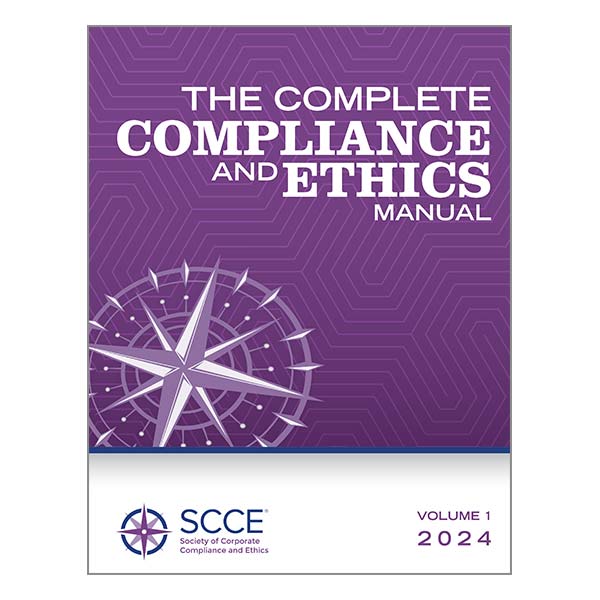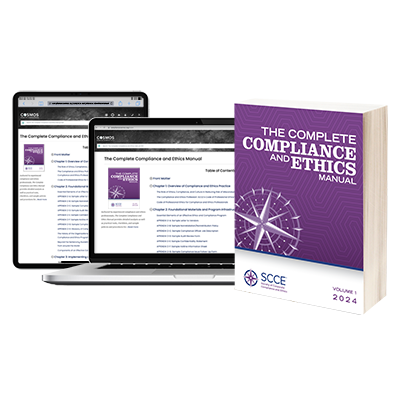Chapter 1: Overview of Compliance and Ethics Practice
- The Role of Ethics, Compliance, and Culture in Reducing Risk of Misconduct
- The Compliance and Ethics Profession: SCCE’s Code of Professional Ethics for Compliance and Ethics Professionals
- Code of Professional Ethics for Compliance and Ethics Professionals
- Ethics at Every Level: Safeguarding Your Organization from Misconduct
Chapter 2: Foundational Materials and Program Infrastructure
- Essential Elements of an Effective Ethics and Compliance Program
- Appendix 2-A: Sample Letter to Vendors on Gift-Giving Limitations
- Appendix 2-B: Model Anti-Retaliation Policy
- APPENDIX 2-C: Sample Compliance Officer Job Description
- Appendix 2-D: Sample Compliance Audit Report Form
- Appendix 2-E: Sample Compliance Committee Member Confidentiality Commitment
- Appendix 2-F: Compliance Issue Report Intake Form
- Appendix 2-G: Glossary of Compliance-Related Terms
- The History of the Organizational Sentencing Guidelines and the Emergence of Effective Compliance and Ethics Programs
- Beyond the Sentencing Guidelines: Governing Directives, Guidelines, and Standards from the United States
- Components of an Effective Compliance and Ethics Program
Chapter 3: Implementing a Program
- Getting Started
- Initial Steps for Building a Compliance and Ethics Program
- Appendix 3-A: Compliance Program Implementation Checklist
- APPENDIX 3-B: Compliance Job Description
- Appendix 3-C: Compliance Program Risk Catalog and Assessment
- APPENDIX 3-D: Sample Compliance Committee Charters
- APPENDIX 3-E: Sample Policies and Procedures
- Making the Business Case: Selling Compliance and Ethics to Management
- Appendix 3-F: Calculating the Value of Your Corporate Compliance Program
- Compliance Standards and Procedures
- Creating an Effective Code of Conduct and Code Program
- Communicating Values Across Cultures: Globalizing Your Code of Ethics
- Appendix 3-G: Considerations for Global Code Implementation and Rollout
- Developing and Implementing Policies for an Effective Program
- Appendix 3-H: Model Policy Management Policy
- Appendix 3-I: Sample Policy Template
- Appendix 3-J: Sample Compliance Policy Management Checklist
- Appendix 3-K: Sample Compliance Communications Plan
- Program Oversight and Management
- Structuring the CECO and Compliance Function for Success
- Board Engagement, Training, and Reporting
- Yes, a Board can Positively Affect Culture: 10 Practical Actions
- Delegation of Authority
- Due Diligence in Hiring and Promotions: Implementation and Management
- Auditing and Monitoring
- Auditing and Monitoring
- Appendix 3-M: Sample Compliance Auditing and Monitoring Plan
- Education and Awareness
- Essential Steps for Ethics and Compliance Program Branding and Marketing
- Appendix 3-L: Branding and Marketing Resources
- Training by Design
- Creating Effective Compliance Training
- Fraud Awareness Training: Enhancing a Low Cost, High Impact Control in Challenging Economic Times
- 3M’s Transparency Journey: Using Ethics and Compliance Cases as Teaching Tools
- Onboarding as a Key to an Effective Compliance Program
- Internal Reporting Systems
- Why Employees Don't Speak Up and How to Fix It
- Hotline and Whistleblowing Reporting Mechanisms
- Whistleblowing Legislation in the EU and Brazil
- Appendix 3-N: Example Whistleblower System Policy Framework
- Appendix 3-O: Checklist of Processes and Controls to Consider When Establishing a Whistleblower System
- Investigation and Response
- Creating an Organizational Investigations Program and Conducting Effective Workplace Investigations
- Appendix 3-P: Checklist of Core Internal Investigator Competencies
- Appendix 3-Q: Model Internal Investigations Policy
- Appendix 3-R: Sample Upjohn Warning
- Appendix 3-S: Sample Investigation Report Form
- Appendix 3-T: Sample Investigator Script
- Procedures and Guidance for Independent Investigations Overseen by the Audit Committee
- Root Cause Analysis: A Critical Ethics and Compliance Practice for Getting to the Why
- What to Do When the Government Comes Knocking
- Discipline and Incentives
- Employee Discipline and Compliance
- Using Incentives in Your Compliance and Ethics Program
- Appendix 3-U: Sample Manager Evaluation Checklist
- Appendix 3-V: Sample Employee Integrity Recognition Letter
- Appendix 3-W: Ideas for Using Incentives in Compliance and Ethics Programs
- Risk Assessment and Management
- Compliance and Ethics Risk Assessments
- How to Protect Compliance Risk Assessments from Unwanted Disclosure
- Third-Party Risk Management: The Who, What, Why, When, and How
Chapter 4: Measuring Effectiveness
- Compliance and Ethics Program Self-Assessment: Key Considerations
- Appendix 4-A: Compliance and Ethics Program Self-Assessment Questions
- Methods and Guidelines for Demonstrating Compliance Program Effectiveness
Chapter 5: Specific Compliance and Ethics Risks
- Anti-Corruption and Anti-Bribery
- Anti-bribery and Corruption Compliance Programs
- APPENDIX 5-A: Additional Resources on Anti-Corruption and Anti-Bribery
- Appendix 5-B: Considerations in Compliance Education Program Development
- Appendix 5-C: Best Practices Checklist for Managing Third-Party Risk
- Appendix 5-D: Common Red Flags Indicating Heightened Potential for Corruption
- The UK Bribery Act 2010
- APPENDIX 5-E: Bribery Act Resources
- A Global Standard to Address Bribery Risk: ISO 37001
- Anti-Corruption Laws/Regulations in Latin America
- APPENDIX 5-F: Latin America Anti-Corruption Resources
- Anti-Money Laundering
- Anti-Money Laundering Compliance Programs for Financial Institutions and Other Businesses
- Customer Due Diligence and Beneficial Ownership
- Antitrust/Competition Law
- Federal Antitrust Law Risks
- APPENDIX 5-G: Federal Antitrust Law Key Resources
- Antitrust Compliance in Canada
- Antitrust Compliance Programs as Evaluated by the Antitrust Division of the U.S. Department of Justice
- Conflicts of Interest
- Conflicts of Interest
- Appendix 5-H: Model Conflicts of Interest Policy
- Conflicts of Interest: Evaluating Outside Board of Director and Advisory Service Roles
- Gifts and Entertainment Compliance
- Entity-Specific Risk Management
- Government Agencies: Effective Compliance and Ethics Programs are Necessary for Public Trust
- Environmental Liabilities
- Environmental Law and Compliance
- Appendix 5-I: Environmental Risk Factors and Mitigating Measures
- Appendix 5-J: Environmental Compliance Program Self-Assessment Questionnaire
- Compliance Professionals as the New Face of ESG Leadership
- ESG, Cyber, and Privacy: Bridging the Divide
- Government Contracting and RelationshipsG
- Government Contractor Integrity and Responsibility: Risks and Opportunities in the Federal Marketplace
- Compliance Overview: Corporate Involvement in the Federal Public Policy Arena
- Government Enforcement Actions and Disclosures
- Voluntary Disclosure, Mandatory Disclosure, and Government Engagement
- Corporate Probation: The Use of Independent Monitors to Improve Compliance and Prevent Fraud
- False Claims Act Risks
- APPENDIX 5-K: False Claims Act References to Key Resources
- Identity Verification
- Compliance and Fake IDs: Complications of Checking ID and Confirming Identity
- Labor/Employment
- Wage and Hour Compliance Under Federal and State Laws
- Harassment in the Workplace: Leadership Impact and the Role of the Compliance and Ethics Practitioner
- Building Cultures of Integrity in Remote and Hybrid Environments
- The Changing Landscape of Cannabis Legalization: Compliance and Ethics Program Challenges
- Mergers and Acquisitions
- Effective Ethics and Compliance Due Diligence during Mergers and Acquisitions
- Privacy and Data Protection
- A Data Privacy Compliance Program Primer: A Snapshot of Data Privacy Regulations, Risks, and Compliance and Risk Management Effectiveness Strategies
- Does GDPR Apply to My Organization?
- The Role of the Data Protection Officer in Europe
- Privacy in the European Union: A Data Safekeeping Revolution
- A New Decade in Data Privacy: Complying with the CCPA
- Bring Your Own Device Policies and Practices
- Cybervigilance in Establishing Security Cultures
- Cyber Insurance Guidelines for Corporate Compliance and Ethics Executives and Boards of Directors
- Appendix 5-L: Self-Assessment to Determine Cyber Insurance Risk
- Appendix 5-M: Recommendations to Prepare for and Reduce the Cost of Cyber Insurance
- Appendix 5-N: Common Cyber Insurance Mistakes to Avoid
- Data Mapping: A Necessary Risk Management Tool for Data Compliance
- Security Incident and Data Breach Response
- Records Management and Retention
- Creating an Effective Data and Information Governance Program
- Appendix 5-O: Model Record Retention Policy
- Appendix 5-P: Sample Record Retention Schedule Chart
- Appendix 5-Q: Sample Litigation Hold Notice
- Appendix 5-R: Sample Record Retention Decision Tree Tool
- Social Media
- Social Media Compliance
- Appendix 5-S: Model Social Media Policy
- Supply Chain
- Human Trafficking Prevention in the Supply Chain
- Complying with the SEC's Conflict Minerals Rule: An Overview for Compliance Professionals
- Technology and Compliance
- Artificial Intelligence and Corporate Compliance
- The Relationship between Technology and Compliance
- Data Analytics for Compliance
- Ethics, Compliance, and Artificial Intelligence
- Harnessing Technology for Auditing and Monitoring in the Digital Era
- Trade Compliance
- Corporate Compliance in a Geopolitical World: OFAC’s Framework for Compliance Commitments
- International Trade and Business: US Export Controls
- APPENDIX 5-T: International Trade References and Links to Key Resources
- U.S. Antiboycott Laws: Understanding the Impact and Ensuring Compliance





